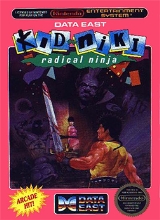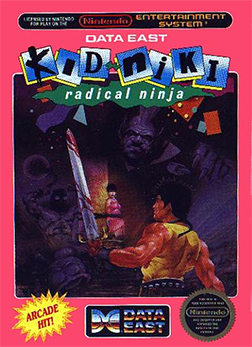
Kid Niki: Radical Ninja
Encyclopedia
Kid Niki: Radical Ninja, known in Japan
as , is an arcade game
developed and published by Irem in 1986, and was later published outside of Japan by Data East
in 1987. The arcade game runs on Irem-62 Hardware, the same as Kung-Fu Master
.
The differences between the Kid Niki: Radical Ninja and Kaiketsu Yancha Maru are minimal. Aside from text translation, the most glaring difference is the main character's hair style. Kid Niki's hair is more "punk rock" with wild spikes and a ponytail in the back. Yancha Maru's hair has more subdued spikes and a topknot (or chonmage
). In the arcade version of the game, the main character's keikogi
is yellow while it is red in the home ports.
School. Suddenly, a passing bird is struck down by an arrow and lands at Niki's feet. Attached is a note explaining that Niki's girlfriend, Princess Margo, has been kidnapped by the evil Stone Wizard. With the cry of "Will help you!" Niki bursts through the wall of his school and sets off on his quest to save Margo.
In addition to the spinning sword, Kid Niki can gain extra offensive power by collecting Bells. The Golden Bell allows him to launch a projectile every time Kid Niki spins his sword, and the Silver Bell creates a spinning force field around him. Both of these power-ups last for a limited amount of time.
The game is divided up into seven rounds, with a boss character at the end of each one. These bosses are:
 In 1987, Data East
In 1987, Data East
released ports of the game for the NES
, Commodore 64
, and Apple II
. Curiously, all home versions of the game show screen shots from the graphically superior arcade version on the back of their packages. Although it is an Irem game, the home ports were one of the more successful games released by Data East
.
In Japan, two sequels appeared for the Famicom
. The first was Kaiketsu Yanchamaru 2: Karakuri Land in 1991, and the second was Kaiketsu Yanchamaru 3 in 1993. Each of the three NES/Famicom titles feature radically different character designs.
There was also a Game Boy
sequel called Ganso!! Yanchamaru in 1991. This portable sequel is a unique game and not a port of one of the existing Kid Niki/Yanchamaru titles.
Kid Niki makes a cameo appearance in Irem's NES
game, Kickle Cubicle
. To see Kid Niki, hold down the A button on Controller 2, and then turn on the game. Continue holding A until the title screen appears, and Kid Niki will appear. This trick also works on the Famicom
version of Kickle Cubicle
.
Japan
Japan is an island nation in East Asia. Located in the Pacific Ocean, it lies to the east of the Sea of Japan, China, North Korea, South Korea and Russia, stretching from the Sea of Okhotsk in the north to the East China Sea and Taiwan in the south...
as , is an arcade game
Arcade game
An arcade game is a coin-operated entertainment machine, usually installed in public businesses such as restaurants, bars, and amusement arcades. Most arcade games are video games, pinball machines, electro-mechanical games, redemption games, and merchandisers...
developed and published by Irem in 1986, and was later published outside of Japan by Data East
Data East
also abbreviated as DECO, was a Japanese video game developer and publisher. The company was in operation from 1976 to 2003, when it declared bankruptcy...
in 1987. The arcade game runs on Irem-62 Hardware, the same as Kung-Fu Master
Kung Fu Master
Kung-Fu Master, known in Japan as , is a beat 'em up arcade game developed and published in Japan by Irem. It was later published in North America by Data East. The Japanese version was based on the Jackie Chan movie Wheels on Meals, known as Spartan X in Japan, and credited "Paragon Films Ltd.,...
.
The differences between the Kid Niki: Radical Ninja and Kaiketsu Yancha Maru are minimal. Aside from text translation, the most glaring difference is the main character's hair style. Kid Niki's hair is more "punk rock" with wild spikes and a ponytail in the back. Yancha Maru's hair has more subdued spikes and a topknot (or chonmage
Chonmage
The chonmage is a form of Japanese traditional haircut worn by men. It is most commonly associated with the Edo Period and samurai, and in recent times with sumo wrestlers...
). In the arcade version of the game, the main character's keikogi
Keikogi
or dōgi is a uniform for training, used in martial arts derived from Japan, or budō. . The prototype for the modern keikogi emerged in the late 19th century. The keikogi was developed by judo founder Kano Jigoro...
is yellow while it is red in the home ports.
Plot
One day in Feudal Japan, Kid Niki, the most radical of ninjas, is training at his NinjaNinja
A or was a covert agent or mercenary of feudal Japan specializing in unorthodox arts of war. The functions of the ninja included espionage, sabotage, infiltration, and assassination, as well as open combat in certain situations...
School. Suddenly, a passing bird is struck down by an arrow and lands at Niki's feet. Attached is a note explaining that Niki's girlfriend, Princess Margo, has been kidnapped by the evil Stone Wizard. With the cry of "Will help you!" Niki bursts through the wall of his school and sets off on his quest to save Margo.
Gameplay
Kid Niki is armed with the Spinning Sword, which according to the game's manual, "has been passed down from generation to generation from the School of Chirin."In addition to the spinning sword, Kid Niki can gain extra offensive power by collecting Bells. The Golden Bell allows him to launch a projectile every time Kid Niki spins his sword, and the Silver Bell creates a spinning force field around him. Both of these power-ups last for a limited amount of time.
The game is divided up into seven rounds, with a boss character at the end of each one. These bosses are:
- Round 1: Death Breath
- Round 2: Spike
- Round 3: Horned Witch
- Round 4: Green Grub
- Round 5: Mad Monk
- Round 6: Samurai Guard
- Round 7: Stone Wizard
Ports and related releases

Data East
also abbreviated as DECO, was a Japanese video game developer and publisher. The company was in operation from 1976 to 2003, when it declared bankruptcy...
released ports of the game for the NES
Nintendo Entertainment System
The Nintendo Entertainment System is an 8-bit video game console that was released by Nintendo in North America during 1985, in Europe during 1986 and Australia in 1987...
, Commodore 64
Commodore 64
The Commodore 64 is an 8-bit home computer introduced by Commodore International in January 1982.Volume production started in the spring of 1982, with machines being released on to the market in August at a price of US$595...
, and Apple II
Apple II
The Apple II is an 8-bit home computer, one of the first highly successful mass-produced microcomputer products, designed primarily by Steve Wozniak, manufactured by Apple Computer and introduced in 1977...
. Curiously, all home versions of the game show screen shots from the graphically superior arcade version on the back of their packages. Although it is an Irem game, the home ports were one of the more successful games released by Data East
Data East
also abbreviated as DECO, was a Japanese video game developer and publisher. The company was in operation from 1976 to 2003, when it declared bankruptcy...
.
In Japan, two sequels appeared for the Famicom
Nintendo Entertainment System
The Nintendo Entertainment System is an 8-bit video game console that was released by Nintendo in North America during 1985, in Europe during 1986 and Australia in 1987...
. The first was Kaiketsu Yanchamaru 2: Karakuri Land in 1991, and the second was Kaiketsu Yanchamaru 3 in 1993. Each of the three NES/Famicom titles feature radically different character designs.
There was also a Game Boy
Game Boy
The , is an 8-bit handheld video game device developed and manufactured by Nintendo. It was released in Japan on , in North America in , and in Europe on...
sequel called Ganso!! Yanchamaru in 1991. This portable sequel is a unique game and not a port of one of the existing Kid Niki/Yanchamaru titles.
Kid Niki makes a cameo appearance in Irem's NES
Nintendo Entertainment System
The Nintendo Entertainment System is an 8-bit video game console that was released by Nintendo in North America during 1985, in Europe during 1986 and Australia in 1987...
game, Kickle Cubicle
Kickle Cubicle
Kickle Cubicle, known in Japan as , is a puzzle game developed by Irem for the arcades in 1988 and then ported to Nintendo Entertainment System in 1990. Gameplay is somewhat similar to the Adventures of Lolo series.-Story:...
. To see Kid Niki, hold down the A button on Controller 2, and then turn on the game. Continue holding A until the title screen appears, and Kid Niki will appear. This trick also works on the Famicom
Nintendo Entertainment System
The Nintendo Entertainment System is an 8-bit video game console that was released by Nintendo in North America during 1985, in Europe during 1986 and Australia in 1987...
version of Kickle Cubicle
Kickle Cubicle
Kickle Cubicle, known in Japan as , is a puzzle game developed by Irem for the arcades in 1988 and then ported to Nintendo Entertainment System in 1990. Gameplay is somewhat similar to the Adventures of Lolo series.-Story:...
.

